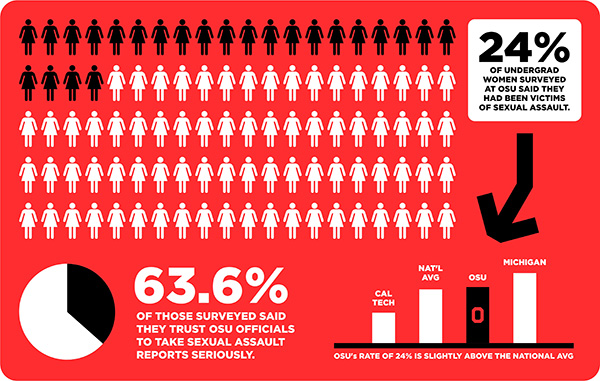
Ohio State statistics from the Association of American Universities’ national campus climate survey on sexual misconduct and relationship violence. Credit: Denny Check / Design Editor
The Association of American Universities released its national campus climate survey on sexual misconduct and relationship violence on Monday, and Ohio State plans to improve its numbers.
Survey results indicated that 24 percent of undergraduate women said that while at OSU, they have been victims of nonconsensual sexual contact as a result of physical force or in situations when they were incapacitated and unable to consent.
As for undergraduate males, 5.3 percent said they have been victims of either nonconsensual penetration or sexual touching while at OSU.
Michael Oney, a fifth-year in zoology, said he thinks those statistics are a little high but isn’t too surprised.
“With underage drinking and the new freedoms kids experience in college, it isn’t surprising that these things occur with a student body this large,” Oney said.
OSU voluntarily participated in the climate survey along with 26 other major universities, including the University of Florida, Cornell University and the University of Michigan.
The university has started an initiative called Buckeyes ACT to not only reduce the amount of sexual assaults but also to raise awareness.
“Campuses must be safe places to learn and grow,” University President Michael Drake said. “Ohio State’s participation in this survey offers valuable insights from our students as the university provides leadership on this national issue.”
The Buckeyes ACT initiative involves three steps: action, counseling and training. This is the newest phase in of OSU’s effort to combat sexual assaults.
“This program is a huge step in the right direction,” said Abby Grossman, a fourth-year in math education and Undergraduate Student Government president.
“Creating awareness in the entire Ohio State community will absolutely begin the change in culture that we need,” she said. “ACT stands for action, counseling and training in which Dr. Drake and Provost (Joseph) Steinmetz have provided our campus community with the resources they need to become a part of the solution.”
With this new initiative and previous initiatives, some students haven’t and still don’t think they are as safe as they need to be.
“I feel that as a woman, I should always be alert and concerned about being sexually assaulted, no matter where I am,” said Amiah Matthews, a second-year in public health. “I do feel safer on campus grounds. However, I do dread walks along High Street because I’ve been catcalled many times there before. Being sexually assaulted is always in the back of my mind whether I like it or not, and I’m sure that’s probably the case for most women.”
Rehman Kaludi, a second-year in aerospace engineering, said he thinks that the campus is safe, but more needs to be done off campus.
“I feel very safe when I’m on the main academic part of campus but not very safe when I’m walking home at night, especially east of Summit Street,” Kaludi said.
In the survey, 63.6 percent of OSU students said they felt it was “very or extremely likely” that campus officials would take a report of sexual assault or sexual misconduct seriously.
“OSU is not the only place that doesn’t take reports seriously,” said Gina DeSimone, a fourth-year in business operations management. “This is a nationwide issue. Many people think that people report sexual-assault incidents for attention. This is unfortunate because it inhibits many others from reporting assaults. I think it depends on the situation and who you are talking to. Some people may take you seriously, some may not. These reports should not be taken lightly, and each victim needs to be taken seriously.”
Some students think that OSU is doing a good job with the issue of sexual assault, but not so much the University Police.
“Ohio State seems to be doing well so far at least implementing serious programs about advocacy about the reality of sexual assault and also providing resources for victims on campus,” said Mary Hannon, a fourth-year in strategic communication.
“Personally, the Ohio State Police Department has done nothing to make me feel
protected from crime, assault or anything for that matter,” she said. “If I feel unsafe, I call the Columbus nonemergency line to report suspicions. Ohio State police department specifically hasn’t done anything visible to help any cause, let alone sexual assault for that matter.”
The climate survey was sent to all OSU students, but only 18.1 percent responded.
“This is something that concerns me,” said Grossman. “While knowing 18 percent of our data is an improvement than what we had before, we still are unaware of 82 percent of our community’s situations, which can make a big change on what statistics show.”


